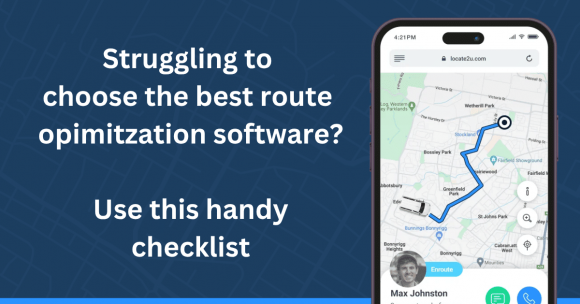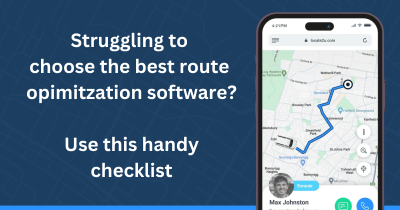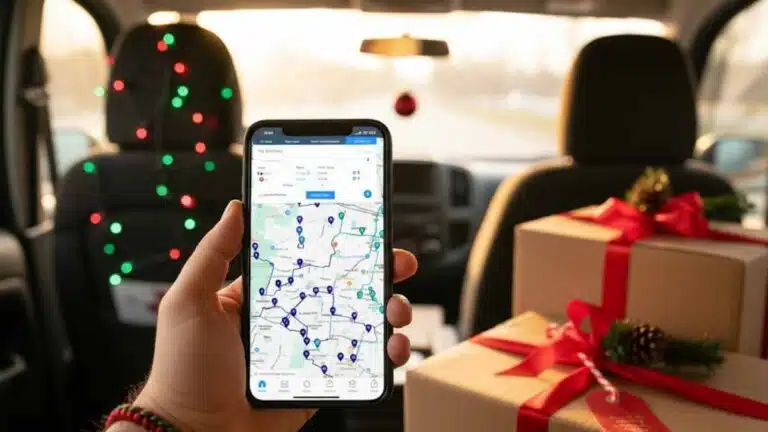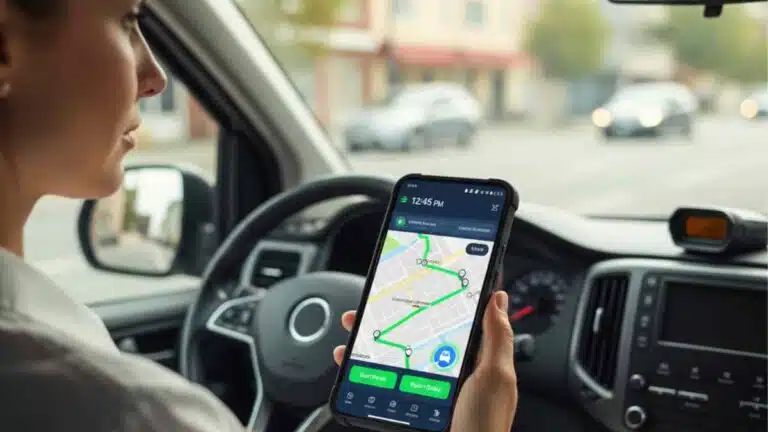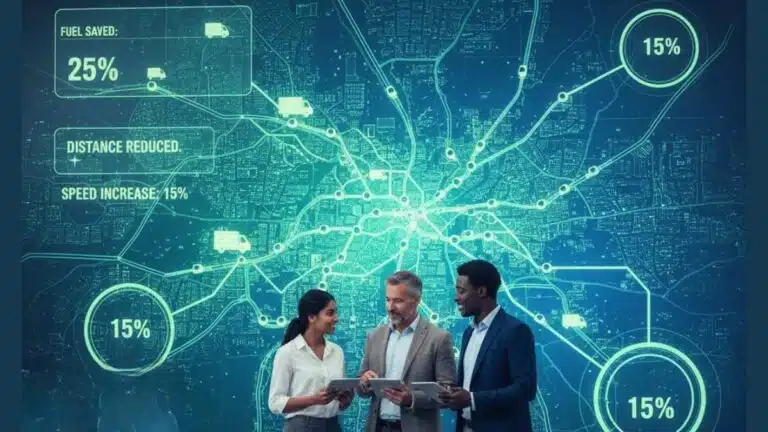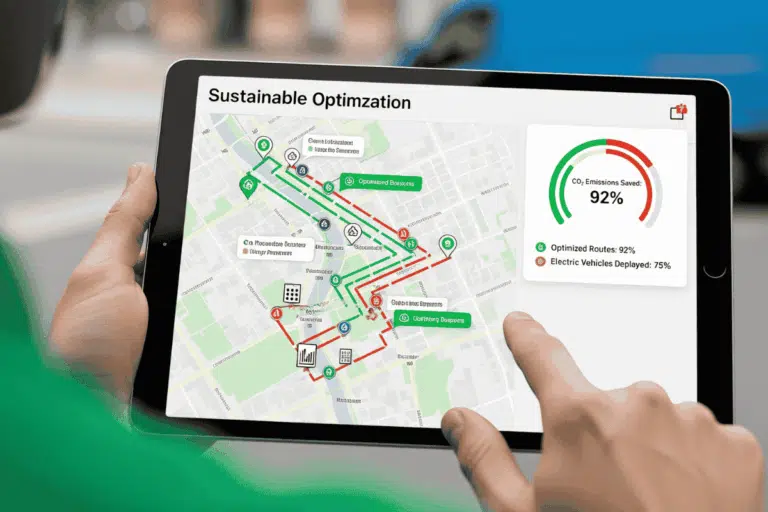Choosing the right route optimization software is all about finding the tool that fits your business like a glove. Whether you’re running a small local delivery service or managing a full fleet across multiple cities, the right software can make a massive difference.
It can save you time, help you cut down on fuel expenses, and even eliminate customer service headaches.
But with so many options out there, how do you know which route optimization software is the best fit for your delivery business?
In this article, we’ll break down exactly what you should look for when picking route optimization software that helps your business grow.
What is route optimization software?
Let’s look at the simplest definition:
Route optimization software makes your deliveries easier to manage by streamlining operations. It does this by generating the most efficient routes for drivers.
The software uses real-time data like traffic, delivery windows, road conditions, weather, and even your vehicles’ capacity to build these routes.
There is an important distinction, though: Route optimization is not basic navigational software. It’s about smart planning, before the driver even leaves your warehouse.
FURTHER READING: Route optimization software explained
Why route optimization matters for delivery businesses
The key benefits of route optimization software make it invaluable for delivery businesses. These benefits include:
- Shorter delivery times
- Lower fuel costs and operational expenses
- Happier customers with more accurate ETAs
- Less stress for drivers
Let’s break it down
1. Efficiency = money saved
With route optimization software, your drivers spend less time on the road. That means more deliveries per day.
And since the routes are optimized for efficiency, your drivers are bogged down with the worry of figuring out manually which is the best route for the deliveries.
READ MORE: 14 Ways Route Optimization Saves Your Business Money
2. Customer expectations are higher than ever
Customers expect live tracking and accurate ETAs. Remember: They have busy lives and busy schedules, likely juggling work, family responsibilities, and more.
Giving them an exact ETA of when their parcel will arrive, along with a live tracking link so they can follow the status of the delivery, will make it so much easier for them.
3. Manual planning doesn’t scale
Sad but true: manual planning might suffice when you’re planning just five deliveries a day.
But what happens when your company grows, and now you have to manage 50 deliveries, a day. Or a 100? What about a 1000 stops?
This is where route optimization swoops in to save the day (and money!)
4. Fuel and maintenance costs are a major overhead
Optimized routes mean fewer miles driven = lower costs.
Every route you can optimize for efficiency means fewer miles travelled (and along with that, less fuel burned, and more savings.)
Locate2u’s route optimization software, for example, uses real-time data to update routes dynamically, helping companies stay on schedule despite changing conditions.
In fact, Locate2u is helping Melany Food Company to ship their award-winning artisanal gelato and sorbet without hassle:
When Maleny Food Co. started small in 2001, they managed deliveries with one vehicle that barely filled up. That changed when they began to scale.
As director Norman Scott puts it, Locate2u’s software removes a lot of that knowledge void that used to exist, allowing the company to focus on what it does best.
READ: Maleny Food Co improves delivery accuracy with real-time tracking
How to choose the best route optimization software
Now it’s the fun part, choosing the right software for you! Fret not, we’ve made a checklist to make this process as pain-free as possible.
1. Look for real-time traffic integration
- Software should adapt to real-time traffic, accidents, or road closures.
- Dynamic rerouting is key for avoiding delays.
2. Prioritize ease of use
- The interface must be simple enough for dispatchers and drivers.
- Look for mobile app compatibility for drivers on the go.
3. Check multi-stop and bulk delivery capabilities
- Can the software handle dozens (or hundreds) of stops at once?
- Can it prioritize deliveries based on urgency or time windows?
4. Evaluate proof of delivery features
- Digital signatures, photo capture, and timestamp logs.
- Helps resolve customer disputes and improves accountability.
5. Analyze reporting and analytics
- Can you track on-time delivery rates, driver performance, and fuel savings?
- Data helps you continuously improve and spot bottlenecks.
6. Ensure scalability
- Will it work for 10 vehicles now and 100 vehicles later?
- Make sure it grows with you, not forces a future system change.
7. Check customer support and onboarding help
- You’ll need setup help, troubleshooting, and maybe driver training.
- A responsive support team makes a huge difference.
8. Verify pricing transparency
- Are you charged per driver, per vehicle, or per route?
- Look for clear, scalable pricing without hidden fees.
Route optimization software: final thoughts
If you want to make sure your deliveries run smoother, faster, and smarter, investing in route optimization software is the way to go.
Think about your daily pain points:
- delays,
- wasted fuel,
- missed deliveries.
The right software fixes these before they even happen.
Take your time, do your research, and invest in a tool that makes growth easier, not harder. Your drivers (and your bottom line!) will thank you for it.
NOW READ: 14 Costly Customer Experience Mistakes You’ll Avoid With Route Optimization
About the author
Cheryl has contributed to various international publications, with a fervor for data and technology. She explores the intersection of emerging tech trends with logistics, focusing on how digital innovations are reshaping industries on a global scale. When she's not dissecting the latest developments in AI-driven innovation and digital solutions, Cheryl can be found gaming, kickboxing, or navigating the novel niches of consumer gadgetry.

